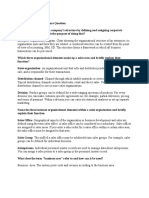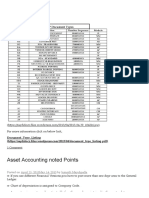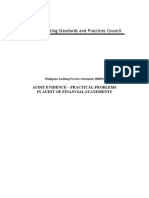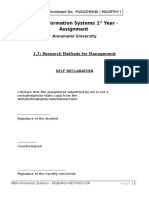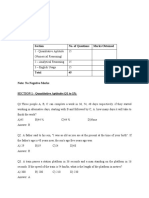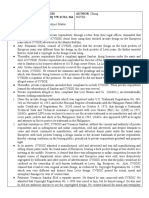Sap Imp
Sap Imp
Uploaded by
rohitmogheCopyright:
Available Formats
Sap Imp
Sap Imp
Uploaded by
rohitmogheOriginal Title
Copyright
Available Formats
Share this document
Did you find this document useful?
Is this content inappropriate?
Copyright:
Available Formats
Sap Imp
Sap Imp
Uploaded by
rohitmogheCopyright:
Available Formats
Topic
Defination A company that purchase SAP software will install it on SAP server which is then configured on for its specific need. This is called an instance. Companies can have more then one SAP Instance, but they will exist on different SAP system. With In one SAP instance, a number of clients will be created. We define a Client as an organizational and legal entity in SAP system. The master Data is protected with in the client as it can not be accessed SAP defines a company and company code seperately. SAP defines a company as the smallest organizationl unit for which legal finance statements can be prepared. A company. A company can contain one or more company codes but they must use the same chart of accounts and same fiscal year break down.
Client
Company
Company Code
SAP defines a company code as the smallest organization unit which a complete self contained set of accounts can be drawn up. You will be able provide data for generating balance sheet & profit & Loss statements. The company code will represent legally independent companies. using more than company code allows a customer to manage financial data for different independent companies at the same time Once a company code has been defined it must be assigned to a number of objects. In the IMG there are number of Financial Configuration steps that need to be carried out. The company code can be assigned to the following: *Credit Control Area *Financial Management Area *Company The defination of Plant is depend on it use. From a material management view a plant can be defined as a location that holds valuated stock. A Production Planing view defines a plant as an organizational unit that is center to production planning. A plant also can be defined as a location that contains service or maintenance facilities **Prerequisites for a plant *Factory Calendar *Contry Key *Region Key
Assigning Company Code
Plant
Valuation Level
The valuation Level is an Important Configuration step because it specifies the level at which material stocks are valuated for the whole client. There are two opetion for the valuation level: Plant level or Company Code Level. Storage location is a place where stock is physically kept with in a plant. There will always be at least one storage locaion defined for one plant. It is the lowest level of location defined with in a material management module Once a Valuation level has been established it is possible to assign a plant to an company code. This assignment is performed so that all plant transactions can be attributed to a single legal entity; that is a company code It is possible to create storage locations automatically when an inward goods movement for a material is performed. The configuration need the plant and/or the type of movement to be defined to allow the automatic creation of storagelocation. The automatic storagelocation will only be activated is the movement is for normal stock, not special stock A where house is a Physical location that contains defined areas that are called storage type and these are then further divided into smaller locations called storage bins. The warehouse is linked to the MM module by assigning warehouse to the storagelocation in mm and if a company has WM and MM activated, the goods movement will require knowlege of the major elements of WM
Storage Location
Assigning Plant
Automatic creation of Storage locations
Warehouse and storage types
The way to ensure that the SAP identifies that certain Storage locations are controlled by the functionality in Assigning a warehouse to Plant and storage location warehouse management is to assign a ware house to a storage location. A storage type is defined as an area of the warehouse that is a sub section containing a number of storage bins. The storage type is available to the warehouse user for creating searches based on storage types. Common storage type in a warehouse will be area such as cold room, bulk storage, and high rack area. storage type pre defined by SAP are called interim storage type. these are defined numerically from 900 to 999. the areas are used by SAP for movement posting such as goods receipt, goods issue and posting difference.
Storage Type
Storage Section
a subdivision of the storage type is storage section. This is simply a group of similar storage bins even if the customer does not want to define storage section, one storage section must be define per storage type. This is normally defined as 001. A Pucrhasing organiztion is simply defined as a group of purchasing activity that is associated with all or a specific part of the enterprise Purchasing for SAP customer may take place at the highest level with in an organization. If a customer has central purchasing dept. that co-ordinate purchasing for all companies with in the enterprise then the purchasing organization can be configured in that manner. The purchasing organization is defined in sap and then assigned to all companies. If a SAP customer does not have a single enterprise wide purchasing function it may have purchasing centralized for each company. This may be appropriate for customer with companies in various countries in which case an enterprise purchasing department not possible. in this scenario a purchasing organization is created and assigned for each company code. even with the scenario a purchasing organization may cover several companies. In an Enterprise that has Companies with larg autonomus plant the purchasing decisions may be at a local level. The SAP customer may decide that assigning one purchasing organization to one company is not appropriate, and it would be a better decision to assign a purchasing organization at the plant. this scenario has an advantage when the vendors are at a local level and few vendors supply material or services to more then one plant.
Purchasing Organization
Purchasing at an enterprise level
Purchasing at an Company level
Purchasing at an Plant level
Reference Purchasing Organization
Create a purchasing Organization
Tcode
Path
OX15
SPRO->IMG->Enterprise Structure->Defination>Financial Accounting->Define Company.
SPRO->IMG->Enterprise Structure->DefinationOX02 >Financial Accounting->Edit. Copy, delete Check company code
OX10
SPRO->IMG->Enterprise Structure->Defination-> Logistic General->Define. Copy, delete Check Plant.
OX14
SPRO->IMG->Enterprise Structure->Defination-> Logistic General->Define. Valuation level
OX09
SPRO->IMG->Enterprise Structure->Defination-> Material Management->Maintain Storage location
OX18
SPRO->IMG->Enterprise Structure->Defination-> Logistic General->Assign Plant to Company code
SPRO->IMG->Material Management-> Inventory OMB3 Management and Physical Inventory-> Goods Receipt>Create Storage location Automatically
SPRO->IMG->Enterprise Structure->Defination-> Logistic Execution-> Define. Copy delete check Wherehouse Number
SPRO->IMG->Enterprise Structure-> Assignment-> Logistic Execution-> Assign Wherehouse Number to plant/storage location
SPRO->IMG-> Logistics Execution-> Warehouse management-> Master Data->Define Storage tpye
SPRO->IMG-> Logistics Execution-> Warehouse management-> Master Data->Define Storage sections
SPRO->IMG->Enterprise Structure-> Assignment-> OX01 Material Management -> Assign Purchasing organization to Company Code
SPRO->IMG->Enterprise Structure-> Assignment-> OX17 Material Management -> Assign Purchasing organization to Plant
SPRO->IMG->Enterprise Structure-> Assignment-> Material Management -> Assign Purchasing organization to Reference purchasing organization SPRO->IMG->Enterprise Structure->Defination-> Material Management ->Maintain purchasing Organization
You might also like
- SAP Enterprise Structure Concept and Configuration Guide: A Case StudyFrom EverandSAP Enterprise Structure Concept and Configuration Guide: A Case StudyRating: 5 out of 5 stars5/5 (3)
- Sap MM Project - Ecc 6.0Document20 pagesSap MM Project - Ecc 6.0Razi Ahmed Khan100% (3)
- SAP SD Interview Questions and Answers: Learning IT Courses Has Never Been This EasyDocument28 pagesSAP SD Interview Questions and Answers: Learning IT Courses Has Never Been This EasychandansuprathikNo ratings yet
- BL AminoacidosDocument1 pageBL Aminoacidosprodesur50% (2)
- SAP MM - Organizational Structure Interview Questions and AnswersDocument4 pagesSAP MM - Organizational Structure Interview Questions and AnswersSambit Mohanty100% (1)
- Organization Structure in SAP Client SCC4: (Rcomp)Document18 pagesOrganization Structure in SAP Client SCC4: (Rcomp)Sambit MohantyNo ratings yet
- SAP Backend Configuration 1614845620Document15 pagesSAP Backend Configuration 1614845620Naveed Nadeem KhanNo ratings yet
- Sap PP Enterprise StructureDocument14 pagesSap PP Enterprise StructureNASEER ULLAHNo ratings yet
- SAP Organisation StructureDocument23 pagesSAP Organisation Structureヴィカス かダムNo ratings yet
- DAY 2 SAP MM BasicsDocument8 pagesDAY 2 SAP MM Basicsfl.munaffNo ratings yet
- SAP MM Organization StructureDocument4 pagesSAP MM Organization StructuregopinathNo ratings yet
- Sap MM Enterprise StructureDocument3 pagesSap MM Enterprise StructureMangezi TaperaNo ratings yet
- SAP MM (Org Structure)Document10 pagesSAP MM (Org Structure)mishrapinkanNo ratings yet
- SAP Enterprise StructureDocument9 pagesSAP Enterprise StructurePriyabrata Ray50% (2)
- Sap Ecc Mm's Configuration - Part 1Document3 pagesSap Ecc Mm's Configuration - Part 1Sap AkhilNo ratings yet
- SAP SD Interview QuestionsDocument11 pagesSAP SD Interview QuestionsrameshNo ratings yet
- FI-MM NotesDocument7 pagesFI-MM NotesKancheti Bhanu PrasadNo ratings yet
- 01enterprise StructureDocument5 pages01enterprise Structureking4u9No ratings yet
- P2P-S2S-IN2REP-Organizational StructureDocument20 pagesP2P-S2S-IN2REP-Organizational StructureZerihun FekadeNo ratings yet
- What Is OrgDocument11 pagesWhat Is OrgpramodNo ratings yet
- SAP WM OverviewDocument64 pagesSAP WM OverviewdineshsapNo ratings yet
- SAP SD Frequently Asked Questions - ERP Operations - SCN WikiDocument6 pagesSAP SD Frequently Asked Questions - ERP Operations - SCN WikiNeeraj JainNo ratings yet
- Sap SD Sale Organization Structure 1Document28 pagesSap SD Sale Organization Structure 1NASEER ULLAHNo ratings yet
- Day 3Document10 pagesDay 3Sarf FaizalNo ratings yet
- SAP Organization StructureDocument19 pagesSAP Organization Structuresurajsroy0% (1)
- Organizational Structure SAP MMDocument7 pagesOrganizational Structure SAP MMjunaidNo ratings yet
- 4.1 Enterprise StructureDocument17 pages4.1 Enterprise StructurekalykumNo ratings yet
- ERP Solved PaperDocument7 pagesERP Solved PaperPraksh chandra Rajeek kumarNo ratings yet
- Sap MMDocument48 pagesSap MMsamar ghorpade100% (1)
- SAP MM - Enterprise StructureDocument5 pagesSAP MM - Enterprise StructureSathya SatzNo ratings yet
- What is Enterprises StructureDocument2 pagesWhat is Enterprises StructureyogeshsupremeilabNo ratings yet
- Sales and Distribution Q & A: Corporate Structure - ERP DatabaseDocument7 pagesSales and Distribution Q & A: Corporate Structure - ERP DatabaseVenkata Nelluri Pmp100% (1)
- SAP SD Frequently Asked QuestionsDocument10 pagesSAP SD Frequently Asked QuestionsKamal BatraNo ratings yet
- SAP FICO Enterprise StructureDocument14 pagesSAP FICO Enterprise Structuresaikumar satyaNo ratings yet
- SAP Sales and Distribution Frequently Asked Combined QuestionDocument164 pagesSAP Sales and Distribution Frequently Asked Combined QuestionNitish Ranjan80% (5)
- MM CookbookDocument68 pagesMM CookbookcolosoderadaNo ratings yet
- Corporate Structure: Organizational UnitsDocument5 pagesCorporate Structure: Organizational Unitssaurabhleo2005No ratings yet
- SAP MM - Enterprise StructureDocument4 pagesSAP MM - Enterprise StructureJancy SunishNo ratings yet
- 1 SAP MM Overview - Free SAP MM TrainingDocument6 pages1 SAP MM Overview - Free SAP MM TrainingabcNo ratings yet
- SAP+S4HANA+Sourcing+&+Procurement+-+Section+ 2Document34 pagesSAP+S4HANA+Sourcing+&+Procurement+-+Section+ 2YOGESH SINGHNo ratings yet
- SAP MM Overview R3Document6 pagesSAP MM Overview R3yusefalvaNo ratings yet
- EWM Organizational StructureDocument25 pagesEWM Organizational Structurezak100% (2)
- SAP MM Erp GreatDocument27 pagesSAP MM Erp GreatMADHU sudhanNo ratings yet
- Sap MM Organization Structure P & ADocument34 pagesSap MM Organization Structure P & ARP TechNo ratings yet
- SAP Consignment ProcessDocument6 pagesSAP Consignment Processyoshi nNo ratings yet
- SAP SD Corporate Structure QuestionDocument43 pagesSAP SD Corporate Structure Questionpradipta1984No ratings yet
- SAP MM-How To Define Purchase Organization in SAPDocument4 pagesSAP MM-How To Define Purchase Organization in SAPmanthuNo ratings yet
- EWM-ECC Organization LevelDocument53 pagesEWM-ECC Organization LevelSwamy KattaNo ratings yet
- Log MM Maa 1Document4 pagesLog MM Maa 1Mohan GanganalaNo ratings yet
- SAP SD Frequently Asked Questions1Document2 pagesSAP SD Frequently Asked Questions1Kamal BatraNo ratings yet
- SAP Organization StructureDocument19 pagesSAP Organization Structuresapcust100% (2)
- SAP SD Organizational Structure: Target Audience of This ArticleDocument7 pagesSAP SD Organizational Structure: Target Audience of This ArticleflorenciaNo ratings yet
- SAP MM Part 1Document61 pagesSAP MM Part 1akshay jadhavNo ratings yet
- SAP FICO Documents - SAP SIMPLE DocsDocument6 pagesSAP FICO Documents - SAP SIMPLE Docsrudy suryaNo ratings yet
- 03 Sap MMDocument11 pages03 Sap MMraj rajanNo ratings yet
- SAP SD Interview Questions and AnswersDocument4 pagesSAP SD Interview Questions and AnswersshabanaNo ratings yet
- Business Blueprint RequirementsDocument6 pagesBusiness Blueprint Requirementsmehedi_orchid100% (1)
- SAP Service Management: Advanced ConfigurationFrom EverandSAP Service Management: Advanced ConfigurationRating: 4.5 out of 5 stars4.5/5 (3)
- SAP PR Release Strategy Concept and Configuration Guide: A Case StudyFrom EverandSAP PR Release Strategy Concept and Configuration Guide: A Case StudyRating: 4 out of 5 stars4/5 (6)
- The Official Supply Chain Dictionary: 8000 Researched Definitions for Industry Best-Practice GloballyFrom EverandThe Official Supply Chain Dictionary: 8000 Researched Definitions for Industry Best-Practice GloballyRating: 4 out of 5 stars4/5 (4)
- Coa Memo 2016Document2 pagesCoa Memo 2016Russel SarachoNo ratings yet
- Effectiveness of Third Party Administrators in Context To Indian Health DR Chhavi AnandDocument11 pagesEffectiveness of Third Party Administrators in Context To Indian Health DR Chhavi AnandeditorialeletsNo ratings yet
- VP Talent Learning Development in Chattanooga TN Resume Traci DayDocument2 pagesVP Talent Learning Development in Chattanooga TN Resume Traci DayTraciDayNo ratings yet
- HOER RulesDocument27 pagesHOER RulesAshlin Augusty100% (1)
- Paps 1000phDocument15 pagesPaps 1000phMarian Barradas ConcibidoNo ratings yet
- Solutions WK 6Document8 pagesSolutions WK 6simamo4203No ratings yet
- Chandu PRJDocument67 pagesChandu PRJAnonymous 22GBLsme1No ratings yet
- International Trade An Essential Guide To The Principles and Practice of ExportDocument392 pagesInternational Trade An Essential Guide To The Principles and Practice of ExportWin Bethe0% (2)
- A R RoqueDocument73 pagesA R RoqueTwish BarriosNo ratings yet
- C.V. of Vinod Kr. DubeyDocument3 pagesC.V. of Vinod Kr. DubeyveekaydubeyNo ratings yet
- Accounting For Revenue and Other Receipts: Lester C. ArnadoDocument39 pagesAccounting For Revenue and Other Receipts: Lester C. ArnadoRica BlancaNo ratings yet
- MDOCODocument4 pagesMDOCOsantosh yevvariNo ratings yet
- E-Magazine February 2017 IssueDocument60 pagesE-Magazine February 2017 IssueVar IndiaNo ratings yet
- L&T Technology Services LTD: Retail ResearchDocument11 pagesL&T Technology Services LTD: Retail Researcharun_algoNo ratings yet
- Assignment - Research Methods For ManagementDocument19 pagesAssignment - Research Methods For Managementnatashashaikh93No ratings yet
- Land Rule BangladeshDocument3 pagesLand Rule BangladeshEmrul HasanNo ratings yet
- WBS WPL PT Palu GadaDocument10 pagesWBS WPL PT Palu GadaLucky AristioNo ratings yet
- Job Coaching For All MNC Caal 9908701362Document7 pagesJob Coaching For All MNC Caal 9908701362balki123No ratings yet
- Section No. of Questions Marks ObtainedDocument12 pagesSection No. of Questions Marks ObtainedNukambica PakalapatiNo ratings yet
- The Allen & Overy M&a Index: 60% Increase in Value of Global Public M&a in q1 2011Document28 pagesThe Allen & Overy M&a Index: 60% Increase in Value of Global Public M&a in q1 2011Shraddha BiradarNo ratings yet
- Product MixDocument16 pagesProduct Mixvinod_auraNo ratings yet
- 109-Entrepreneurship DevelopmentDocument2 pages109-Entrepreneurship Developmentjpkassociates2019No ratings yet
- ICI Paints Final ProjectDocument97 pagesICI Paints Final Projectusman_jamil84100% (6)
- Makeup Business PlanDocument16 pagesMakeup Business PlanNsikak Akwaowo100% (1)
- Bangladesh Steel Bank CodeDocument16 pagesBangladesh Steel Bank CodeshovaghoNo ratings yet
- Ammendments in Direct TaxDocument37 pagesAmmendments in Direct TaxVipul KatariyaNo ratings yet
- Wings Phantom 105Document1 pageWings Phantom 105mdtousifansari0786No ratings yet
- Sambar V Levi StraussDocument3 pagesSambar V Levi Straussnica100% (1)
- Director Operations in Miami FT Lauderdale FL Resume Fernando GarciaDocument2 pagesDirector Operations in Miami FT Lauderdale FL Resume Fernando GarciaFernandoGarcia2No ratings yet













































